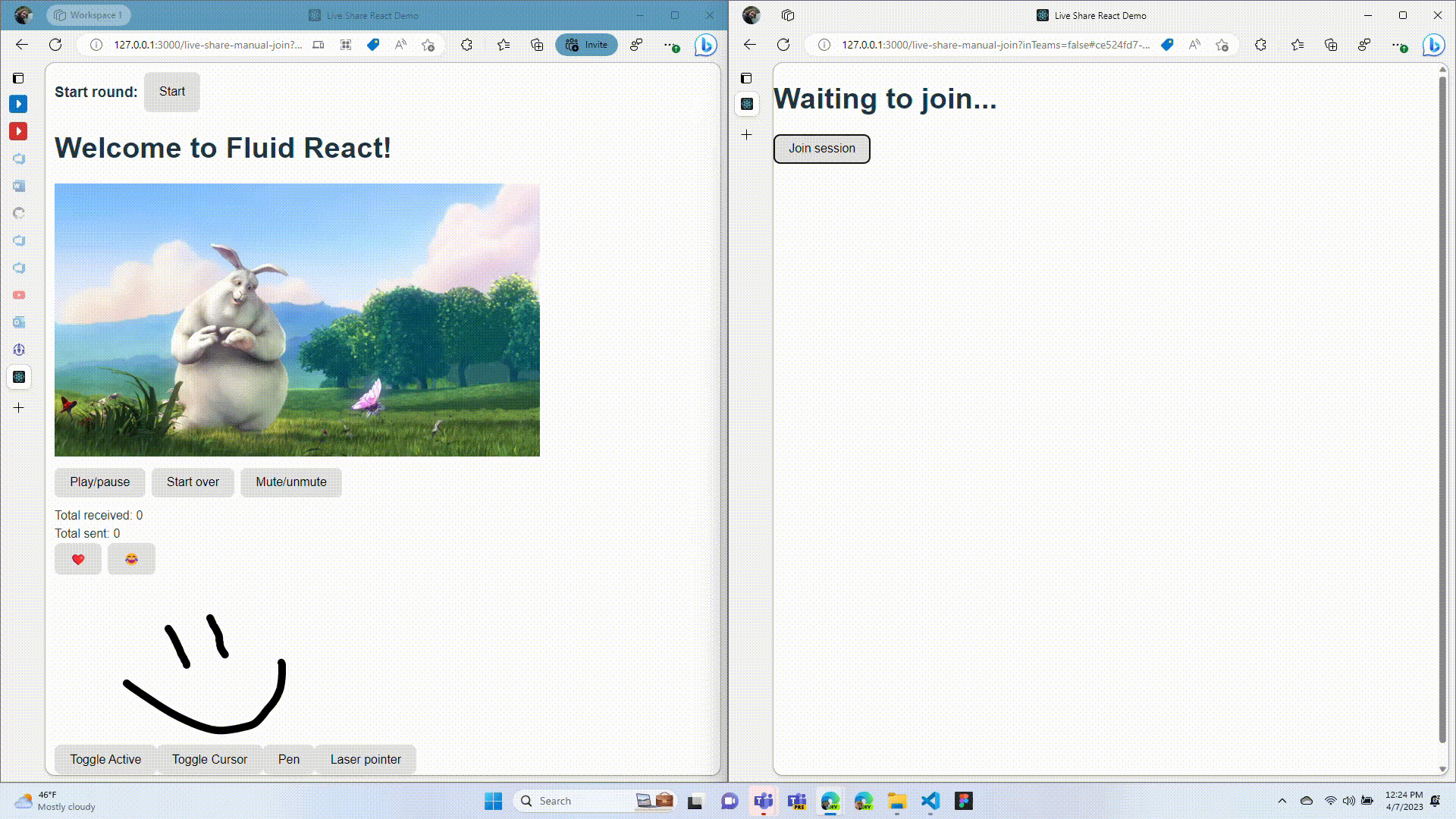This sample shows how to use the Live Share React package in your application. This sample is not intended to show real-world use cases, but rather show simple code examples for each feature of the SDK. For example, LiveShareAutoJoin.jsx shows how to use LiveShareProvider to easily join a Live Share session, while ExampleSharedState.jsx shows how to use the useSharedState hook to synchronize a checkbox.
After cloning the repository, you must first set up the npm workspace from the root of the project. Then, run the following commands from the command line:
npm install
npm run build:packages # Build Live Share packages
cd samples/t*/04*Note: Do not run npm start before running npm run build:packages from the root of the project, unless you first move the sample out of this npm workspace. When using our samples, you are testing the packages using symlinks, and not the Live Share SDK versions published to npm.
Runs the app in the development mode.
Running npm run start, it will do two things: start the tinylicious server and start the application using vite. If you have never used tinylicious before, you should see instead is a prompt saying Ok to proceed? (y), after which you should type y and press the "enter" key. In rare cases you might not see the Ok to proceed? (y) prompt, in which case try running npx tinylicious@latest in your command line directly, and then try again.
Open http://localhost:3000 to view it in your browser.
The page will reload when you make changes.
Upon loading, if there is no /#{id} in the URL, it will create one and insert it into the URL.
You can copy this URL and paste it into new browser tabs to test Live Share using a local server.
To test the side panel & video queue, you can replace your URL with /sidepanel#{id}.
Note: if testing with HTTPS, such as when using a tunneling service like Ngrok, instead use the command npm run start-https.
There are two options for testing this sample in Teams. The first is to use Ngrok to serve and tunnel the app locally, before zipping the app package.
Alternatively, you can use our ready-to-use demo app package. After downloading the zip file, you can skip ahead to the Test it out section.
- Download ngrok.
- Launch ngrok with port 3000.
ngrok http 3000 --host-header=localhost(You will need an ngrok account to use host-header) - In a second terminal, run
npm run start-https(rather than the traditionalnpm run start)
- Open
.\manifest\manifest.jsonand update values in it, including your [Application ID](https://learn.microsoft.com/microsoftteams/platform/resources/schema/manifest-schema#id. - You must replace
https://<<BASE_URI_DOMAIN>>with the https path to your ngrok tunnel. - It is recommended that you also update the following fields.
- Set
developer.nameto your name. - Update
developer.websiteUrlwith your website. - Update
developer.privacyUrlwith your privacy policy. - Update
developer.termsOfUseUrlwith your terms of use.
- Set
- Create a zip file with the contents of
.\manifestdirectory so that manifest.json, color.png, and outline.png are in the root directory of the zip file.- On Windows, select all files in
.\manifestdirectory and compress them to zip. - Give your zip file a descriptive name, e.g.
ContosoMediaTemplate.
- On Windows, select all files in
- Schedule a meeting for testing from calendar in Teams.
- Join the meeting.
- In the meeting window, tap on + Apps and tap on Manage apps in the flyout that opens.
- In the Manage apps pane, tap on Upload a custom app.
- Don't see the option to Upload a custom app?! Follow instructions here to enable custom-apps in your tenant.
- Select the zip file you created earlier and upload it.
- In the dialog that shows up, tap Add to add your sample app into the meeting.
- Now, back in the meeting window, tap + Apps again and type the name of your app in the Find an app textbox.
- Select the app to activate it in the meeting.
- In the configuration dialog, just tap Save to add your app into the meeting.
- In the side panel, tap the share icon to put your app on the main stage in the meeting.
- That's it! You should now see react-media-template on the meeting stage.
- Your friends/colleagues invited to the meeting should be able to see your app on stage when they join the meeting.
To make a new app manifest, you can visit the Teams Developer Portal.
Builds the app for production to the dist folder.
The build is minified and the filenames include the hashes. Your app is ready to be deployed!
